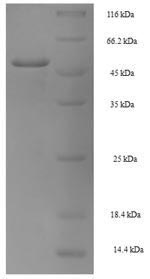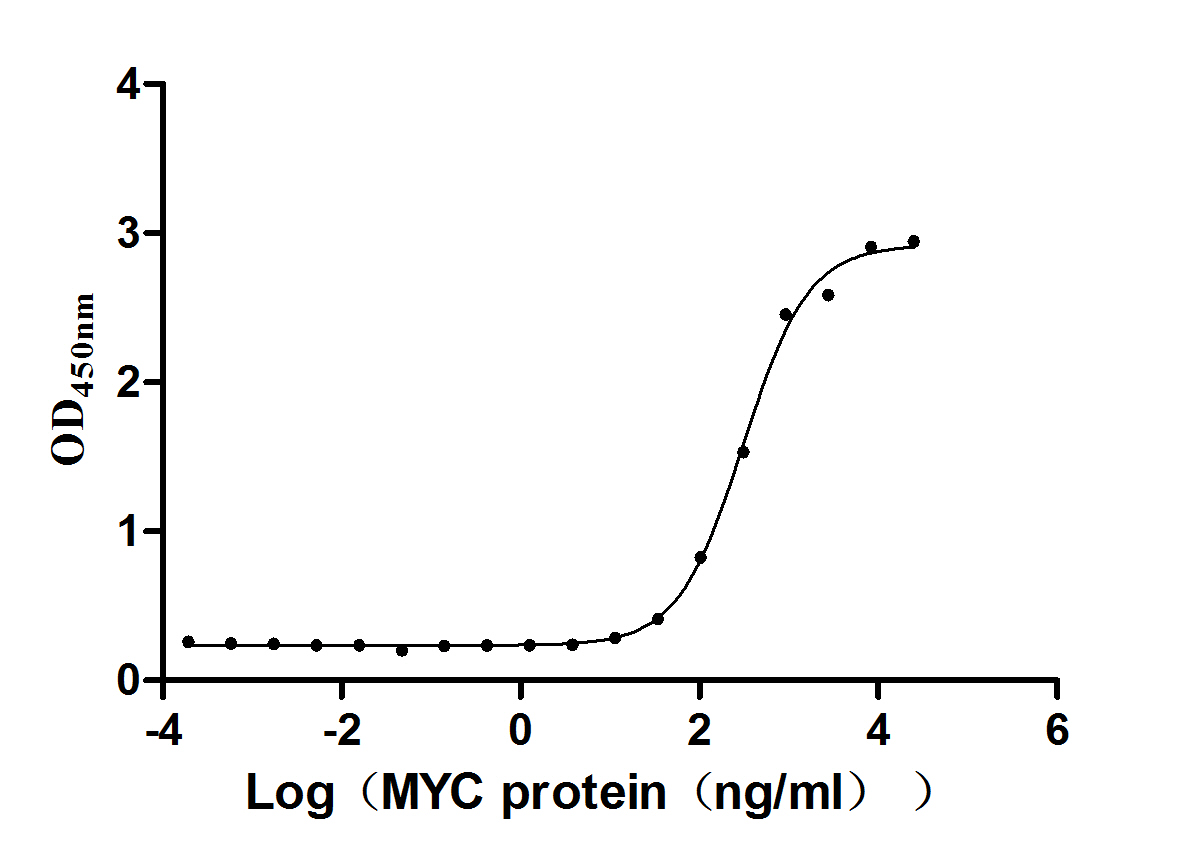Recombinant Human Homeobox protein NANOG (NANOG)
In Stock-
货号:CSB-EP888008HU
-
规格:¥1344
-
图片:
-
其他:
产品详情
-
纯度:Greater than 90% as determined by SDS-PAGE.
-
基因名:
-
Uniprot No.:
-
别名:Embryonic stem cell specific homeobox protein (Nanog); ENK; FLJ12581; hNanog; Homeobox protein NANOG; Homeobox transcription factor Nanog; homeobox transcription factor Nanog-delta 48; NANOG; Nanog homeobox; NANOG_HUMAN
-
种属:Homo sapiens (Human)
-
蛋白长度:Full Length
-
来源:E.coli
-
分子量:50.6kDa
-
表达区域:1-305aa
-
氨基酸序列MSVDPACPQSLPCFEASDCKESSPMPVICGPEENYPSLQMSSAEMPHTETVSPLPSSMDLLIQDSPDSSTSPKGKQPTSAEKSVAKKEDKVPVKKQKTRTVFSSTQLCVLNDRFQRQKYLSLQQMQELSNILNLSYKQVKTWFQNQRMKSKRWQKNNWPKNSNGVTQKASAPTYPSLYSSYHQGCLVNPTGNLPMWSNQTWNNSTWSNQTQNIQSWSNHSWNTQTWCTQSWNNQAWNSPFYNCGEESLQSCMQFQPNSPASDLEAALEAAGEGLNVIQQTTRYFSTPQTMDLFLNYSMNMQPEDV
Note: The complete sequence including tag sequence, target protein sequence and linker sequence could be provided upon request. -
蛋白标签:N-terminal 6xHis-SUMO-tagged
-
产品提供形式:Liquid or Lyophilized powder
Note: We will preferentially ship the format that we have in stock, however, if you have any special requirement for the format, please remark your requirement when placing the order, we will prepare according to your demand. -
缓冲液:Tris-based buffer,50% glycerol
-
储存条件:Store at -20°C/-80°C upon receipt, aliquoting is necessary for mutiple use. Avoid repeated freeze-thaw cycles.
-
保质期:The shelf life is related to many factors, storage state, buffer ingredients, storage temperature and the stability of the protein itself.
Generally, the shelf life of liquid form is 6 months at -20°C/-80°C. The shelf life of lyophilized form is 12 months at -20°C/-80°C. -
货期:3-7 business days
-
注意事项:Repeated freezing and thawing is not recommended. Store working aliquots at 4°C for up to one week.
-
Datasheet & COA:Please contact us to get it.
相关产品
靶点详情
-
功能:Transcription regulator involved in inner cell mass and embryonic stem (ES) cells proliferation and self-renewal. Imposes pluripotency on ES cells and prevents their differentiation towards extraembryonic endoderm and trophectoderm lineages. Blocks bone morphogenetic protein-induced mesoderm differentiation of ES cells by physically interacting with SMAD1 and interfering with the recruitment of coactivators to the active SMAD transcriptional complexes. Acts as a transcriptional activator or repressor. Binds optimally to the DNA consensus sequence 5'-TAAT[GT][GT]-3' or 5'-[CG][GA][CG]C[GC]ATTAN[GC]-3'. Binds to the POU5F1/OCT4 promoter. Able to autorepress its expression in differentiating (ES) cells: binds to its own promoter following interaction with ZNF281/ZFP281, leading to recruitment of the NuRD complex and subsequent repression of expression. When overexpressed, promotes cells to enter into S phase and proliferation.
-
基因功能参考文献:
- The critical roles of NANOG and its pseudogene NANOGP8 in cancer progression leads the association of these genes with exosomes to be significant, and may allow for exosomal NANOG to function as a powerful diagnostic biomarker. Variations in NANOG/NANOGP8 gene sequences in exosomal DNA includes an insertion into the 3' UTR. PMID: 29787607
- A higher expression of the pluripotency factor NANOG. PMID: 29845283
- The interaction of Nanog with the AR signaling axis might induce or contribute to Ovarian cancer stem cells regulation. In addition, androgen might promote stemness characteristics in ovarian cancer cells by activating the Nanog promoter PMID: 29716628
- The results show that Nanog expression was related to HBsAg, differentiation, and TNM stage in hepatocellular carcinoma (HCC). Nanog may be an unfavorable prognostic biomarker for HCC. PMID: 29198990
- NANOG might be a potential biomarker for early diagnosis of urothelial carcinoma of the bladder. PMID: 29279584
- These results demonstrate that analysis of IHC expression patterns of MK and NANOG in pretreatment biopsy specimens during the work-up period can provide a more definitive prognosis prediction for each oral squamous cell carcinoma (OSCC) patient that can help clinicians to develop a more precise individual treatment modality. PMID: 29113102
- Chicken egg-white extracts promote OCT4 and NANOG expression and telomeres growth in 293T cells. PMID: 28838341
- Rectal tumor tissue OCT4 (p<0.001), SOX2 (p=0.003), and NANOG (p<0.001) expressions were higher than those in adjacent tissue. PMID: 29214774
- Data show that lung adenocarcinoma SPC-A1 cell differentiated by a two-stage induction (TSI) method lost stem cell characteristics, including absent expression of OCT4 and Nanog. PMID: 27588392
- our data suggest that 3D culture increases the expression of Nanog through the relaxation of actin cytoskeleton, which mediates reduced Suv39h1 and H3K9me3 levels. PMID: 28276635
- results show that NANOG could reverse the effects of stem cell senescence and restore the myogenic differentiation potential of senescent MSCs. PMID: 28125933
- MACC1-induced tumor progression in colorectal cancer acts, at least in part, via the newly discovered MACC1/Nanog/Oct4 axis. PMID: 26758557
- RNAi-mediated silencing of NANOG in SKOV-3 reversed the expression of mesenchymal cell markers and restored expression of E-cadherin. Susceptibility to cisplatin increased in SKOV-3 cells on down-regulating NANOG and reversible results were obtained in Moody cells post-overexpression of NANOG. PMID: 27884977
- NANOG enabled reactivation of the ROCK and Transforming Growth Factor (TGF)-beta pathways-both of which were impaired in senescent cells-leading to ACTIN polymerization, MRTF-A translocation into the nucleus and serum response factor (SRF)-dependent myogenic gene expression. PMID: 27350449
- High NANOG expression is associated with brain neoplasms. PMID: 28933914
- Super-enhancers at the Nanog locus differentially regulate neighboring pluripotency-associated genes, in particular, DPPA3. PMID: 27681417
- our data reveal that SATB2 in alveolar bone mesenchymal stem cells (AB-BMSCs) associates with their age-related properties, and prevents AB-BMSCs senescence via maintaining Nanog expression. PMID: 27632702
- High NANOG expression is associated with Multidrug Resistance in breast and cervical cancer. PMID: 28716899
- miR-612 has a suppressive role on hepatocellular carcinoma cell stemness via Sp1/Nanog signaling pathway. PMID: 27685621
- These data reveal an overexpression of NANOG and other markers of pluripotency and stemness in meningiomas. PMID: 28345785
- The NANOG deficiency affected multiple genes, particularly, supressed drug-resistance via down-regulated ABCG2 in Eca109 cells, and caused G1 arrest by down-regulated cyclin D1 (CCND1) expression. PMID: 28601640
- Endogenous Plastic Somatic (ePS) cells in a latent state, i.e. lacking SOX2, OCT3/4 and NANOG (SON) expression, in non-diseased breast specimens through immunohistochemical analysis of previously identified ePS-specific biomarkers (CD73(+), EpCAM(+) and CD90(-)). PMID: 27705752
- Data suggest that C-terminal truncated hepatitis B virus X protein (HBx-DeltaC1) enhances liver cancer stem cell (CSC) properties through Stat3/Nanog cascade, and insight for the therapeutic intervention for hepatitis B virus (HBV)-related hepatocellular carcinoma (HCC). PMID: 28186991
- Nanog directly repressed transcription of the miR-200c and miR-200b genes in colon cancer cells, inducing epithelial-mesenchymal transformation. PMID: 28163188
- LGR5-expressing fraction of CD54+ cells represents gastric cancer CSCs, in which LGR5 is closely associated with stemness and EMT core genes PMID: 28033430
- Data show that Nanog homebox (NANOG) but not sex-determining region Y-box2 (SOX2) and octamer-binding protein 4 (OCT4) expression was overexpressed in the endometrium of women with intrauterine adhesion (IUA). PMID: 28253866
- The NANOG transcription was significantly upregulated by ETV4 overexpression. PMID: 28412366
- Collectively, these findings demonstrate a novel role of YBX1 in maintaining the stemness of CSCs and metastasis, unveiling YBX1 as promising therapeutic target for NSCLC treatments. PMID: 28400280
- the early response of pluripotency genes OCT4 and NANOG to the differentiation-inducing stimuli is mediated by dynamic changes in chromatin marks, while DNA methylation is acquired in the later stages of neurogenesis. PMID: 28601081
- USP21 specifically regulates the Lys48-linked polyubiquitination and stability of NANOG PMID: 27956178
- To our knowledge, this is the first report on lineage reprogramming of TILs using protein stem cell transcription factors delivered directly to the nucleus. PMID: 27084449
- Nanog expression is a prognostic biomarkers for triple-negative breast cancer PMID: 27300169
- Stat3 was correlated with NANOG-mediated EMT. PMID: 26801672
- miR-760 was proved to be functional associated with NANOG via regulating its expression. PMID: 27133070
- SIRT-1 and NANOG are high correlated biological markers for diagnosis and prognosis follow up in patients with adenocarcinoma. PMID: 27540973
- renal cell carcinoma patients with low Nanog and Oct4 expressions in tumor tissues had significantly higher survival rates (p < 0.05). High Nanog and Oct4 expressions may be potential therapeutic targets. PMID: 26631537
- ANOG was regulated by extracellular IGF signaling pathway via STAT3 phosphorylation in colorectal cancer (CRC). This coincides with that IGF receptor IGF-1R is often increasing expressed in malignant metastasis colon cancer. Taken together, our data define the crucial functions of IGF/STAT3/NANOG/Slug signaling axis in the progression of CRC PMID: 26840943
- Nanog is a positive regulator of cervical cancer dedifferentiation. PMID: 26936116
- Data show that long intergenic non-protein coding RNA ROR may act as a competitive endogenous RNAs (ceRNAs), effectively becoming a sink for microRBA miR-145, thereby activating the derepression of core transcription factors Nanog. PMID: 26636540
- ALKBH5 overexpression decreased NANOG mRNA methylation, increased NANOG levels, and increased the percentage of BCSCs, phenocopying the effect of hypoxia PMID: 27001847
- Expression levels of OCT4, SOX2, and NANOG were evaluated by immunohistochemistry with tissue microarray slides of 436 OSCC, 362 corresponding tumor-adjacent normal (CTAN) tissues, and 71 normal uvula epithelium tissues. PMID: 26211876
- Nanog possesses important function in BCSC. PMID: 26339994
- Our study provides new insight into the function of DPPA5 and NANOG regulation in human pluripotent stem cell . PMID: 26661329
- the available data demonstrate that NANOG is strictly involved in the process of carcinogenesis and is a potential prognostic marker of malignant tumors. PMID: 26618281
- the disruption of Nanog expression results in less proliferation, invasiveness, migration, more chemosensitivity and reversal of EMT in HepG2 cells, by which Nanog plays crucial roles in influencing the malignant phenotype of HepG2 cells. PMID: 26676719
- The promoter activity of Nanog and Oct4 were upregulated, and beta-catenin was observed to bind to these promoters during H. pylori infection, while a Wnt/beta-catenin inhibitor suppressed promoter activity and binding. PMID: 26940070
- ectopic expression of Oct-4 gene in hAFMSCs with high self-renewal ability could upregulate Nanog and Sox-2 gene expression PMID: 25385323
- Nanog is an oncogene with multiple roles in promoting tumorigenesis and metastasis PMID: 26073077
- The positive correlation among Oct-4, Nanog, and beta-catenin suggests their coordinated role in maintaining proliferation in oral carcinoma cells. PMID: 24700702
- Oct3/4 and Nanog represent probable CSC markers in HNSCC, which contribute to the development of DNM in part by enhancing cell motility and invasiveness. PMID: 26483189
显示更多
收起更多
-
亚细胞定位:Nucleus.
-
蛋白家族:Nanog homeobox family
-
组织特异性:Expressed in testicular carcinoma and derived germ cell tumors (at protein level). Expressed in fetal gonads, ovary and testis. Also expressed in ovary teratocarcinoma cell line and testicular embryonic carcinoma. Not expressed in many somatic organs and
-
数据库链接:
HGNC: 20857
OMIM: 607937
KEGG: hsa:79923
STRING: 9606.ENSP00000229307
UniGene: Hs.635882
Most popular with customers
-
Recombinant Human papillomavirus type 16 Protein E7 (E7) (Active)
Express system: E.coli
Species: Human papillomavirus type 16
-
Express system: Mammalian cell
Species: Homo sapiens (Human)
-
Recombinant Human Dickkopf-related protein 1 (DKK1) (Active)
Express system: Mammalian cell
Species: Homo sapiens (Human)
-
Recombinant Human Tumor-associated calcium signal transducer 2 (TACSTD2), partial (Active)
Express system: Mammalian cell
Species: Homo sapiens (Human)
-
Recombinant Human Cytotoxic and regulatory T-cell molecule (CRTAM), partial (Active)
Express system: Mammalian cell
Species: Homo sapiens (Human)
-
Recombinant Human Myosin regulatory light chain 12A (MYL12A) (Active)
Express system: E.coli
Species: Homo sapiens (Human)
-
Recombinant Human Transmembrane 4 L6 family member 1(TM4SF1)-VLPs (Active)
Express system: Mammalian cell
Species: Homo sapiens (Human)
-
Recombinant Macaca Gastric inhibitory polypeptide receptor(GIPR), partial (Active)
Express system: yeast
Species: Macaca fascicularis (Crab-eating macaque) (Cynomolgus monkey)





-AC1.jpg)















